
In music performances, rhythm guitar is a technique and role that performs a combination of two functions: to provide all or part of the rhythmic pulse in conjunction with other instruments from the rhythm section ; and to provide all or part of the harmony, i.e. the chords from a song's chord progression, where a chord is a group of notes played together. Therefore, the basic technique of rhythm guitar is to hold down a series of chords with the fretting hand while strumming or fingerpicking rhythmically with the other hand. More developed rhythm techniques include arpeggios, damping, riffs, chord solos, and complex strums.
In music, an ostinato is a motif or phrase that persistently repeats in the same musical voice, frequently in the same pitch. Well-known ostinato-based pieces include both classical compositions, such as Ravel's Boléro and the Carol of the Bells, and popular songs such as Donna Summer and Giorgio Moroder's "I Feel Love" (1977), Henry Mancini's theme from Peter Gunn (1959), The Who's "Baba O'Riley" (1971), and The Verve's "Bitter Sweet Symphony" (1997).
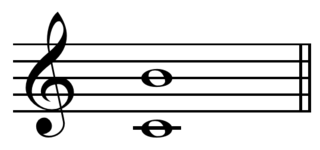
In music from Western culture, a seventh is a musical interval encompassing seven staff positions, and the major seventh is one of two commonly occurring sevenths. It is qualified as major because it is the larger of the two. The major seventh spans eleven semitones, its smaller counterpart being the minor seventh, spanning ten semitones. For example, the interval from C to B is a major seventh, as the note B lies eleven semitones above C, and there are seven staff positions from C to B. Diminished and augmented sevenths span the same number of staff positions, but consist of a different number of semitones.
The intervals from the tonic (keynote) in an upward direction to the second, to the third, to the sixth, and to the seventh scale degrees (of a major scale are called major.
Concerto in F is a composition by George Gershwin for solo piano and orchestra which is closer in form to a traditional concerto than his earlier jazz-influenced Rhapsody in Blue. It was written in 1925 on a commission from the conductor and director Walter Damrosch. It is just over half an hour long.
Ludwig van Beethoven's Piano Sonata No. 3 in C major, Op. 2, No. 3, is a sonata written for solo piano, composed in 1795. It is dedicated to Joseph Haydn and is often referred to as one of Beethoven's earliest "grand and virtuosic" piano sonatas. All three of Beethoven's Op. 2 piano sonatas contain four movements, an unusual length at the time, which seems to show that Beethoven was aspiring towards composing a symphony. It is both the weightiest and longest of the three Op. 2 sonatas, and it presents many difficulties for the performer, including difficult trills, awkward hand movements, and forearm rotation. It is also one of Beethoven's longest piano sonatas in his early period. With an average performance lasting just about 24–26 minutes, it is second only to the Grand Sonata in E♭ Major, Op. 7, published just a year later, in 1796.
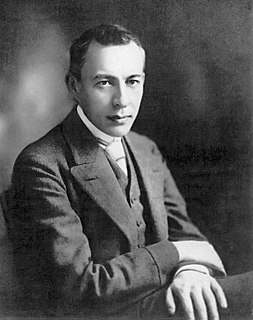
Six moments musicaux, Op. 16, is a set of solo piano pieces composed by the Russian composer Sergei Rachmaninoff between October and December 1896. Each Moment musical reproduces a musical form characteristic of a previous musical era. The forms that appear in Rachmaninoff's incarnation are the nocturne, song without words, barcarolle, virtuoso étude, and theme and variations.

Franz Schubert's Impromptus are a series of eight pieces for solo piano composed in 1827. They were published in two sets of four impromptus each: the first two pieces in the first set were published in the composer's lifetime as Op. 90; the second set was published posthumously as Op. 142 in 1839. The third and fourth pieces in the first set were published in 1857. The two sets are now catalogued as D. 899 and D. 935 respectively. They are considered to be among the most important examples of this popular early 19th-century genre.
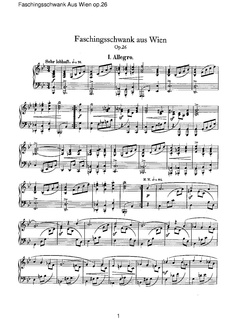
Faschingsschwank aus Wien, Op. 26, is a solo piano work by Robert Schumann. He began composition of the work in 1839 in Vienna. He wrote the first four movements in Vienna, and the last on his return to Leipzig.

American Rhapsody was written for the accordion by John Serry Sr. in 1955 and subsequently transcribed for the free bass accordion in 1963 and for the piano in 2002. The composer was inspired by the classical orchestral works of George Gershwin along with various Latin Jazz percussive rhythms utilized throughout South America while composing this opus.

Jazz improvisation is the spontaneous invention of melodic solo lines or accompaniment parts in a performance of jazz music. It is one of the defining elements of jazz. Improvisation is composing on the spot, when a singer or instrumentalist invents melodies and lines over a chord progression played by rhythm section instruments and accompanied by drums. Although blues, rock, and other genres use improvisation, it is done over relatively simple chord progressions which often remain in one key.
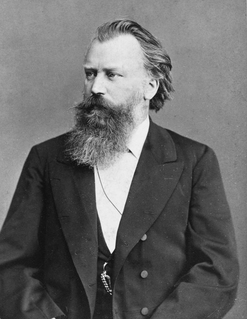
Johannes Brahms's Violin Sonata No. 3 in D minor, Op. 108 is the last of his violin sonatas, composed between 1886 and 1888. Unlike the two previous violin sonatas, it is in four movements. The sonata is dedicated to Brahms' friend and colleague Hans von Bülow, and was premiered in Budapest in 1888 with Jenő Hubay on violin and the composer at the piano.

The Nocturnes, Op. 32 are a set of two nocturnes for solo piano written and published by Frédéric Chopin in 1837. The nocturnes are dedicated to Madame Camile de Billing, and were his ninth and tenth nocturnes published.
"La cathédrale engloutie" is a prelude written by the French composer Claude Debussy for solo piano. It was published in 1910 as the tenth prelude in Debussy's first of two volumes of twelve piano preludes each. It is characteristic of Debussy in its form, harmony, and content.
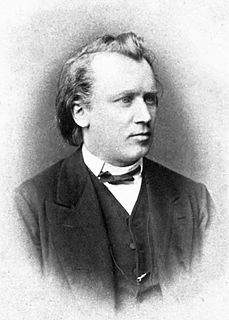
The Piano Quartet No. 3 in C minor, Op. 60, completed by Johannes Brahms in 1875, is scored for piano, violin, viola and cello. It is sometimes called the Werther Quartet after Goethe's The Sorrows of Young Werther.
Excursions, Op. 20, is the first published solo piano piece by Samuel Barber. Barber himself explains:
These are ‘Excursions’ in small classical forms into regional American idioms. Their rhythmic characteristics, as well as their source in folk material and their scoring, reminiscent of local instruments are easily recognized.
Le festin d'Ésope, Op. 39 No. 12, is a piano étude by Charles-Valentin Alkan. It is the final étude in the set Douze études dans tous les tons mineurs, Op. 39, published in 1857. It is a work of twenty-five variations based on an original theme and is in E minor. The technical skills required in the variations are a summation of the preceding études.

This is a list of jazz and popular music terms that are likely to be encountered in printed popular music songbooks, fake books and vocal scores, big band scores, jazz, and rock concert reviews, and album liner notes. This glossary includes terms for musical instruments, playing or singing techniques, amplifiers, effects units, sound reinforcement equipment, and recording gear and techniques which are widely used in jazz and popular music. Most of the terms are in English, but in some cases, terms from other languages are encountered.
Blues, Rags and Stomps, Op. 1, was composed by Robert Boury between 1970-1973. It consists two books, three movements each. Boury composed mostly during his graduate study at the University of Michigan in Ann Arbor. The first set was nicknamed “Varsity Rags”, which Eubie Blake admired and told the audience, “Now that’s ragtime”, after he heard Boury’s performance at the 1971 Toronto ragtime Festival. Book I and II consist of three movements each: I. A Tristan Two-Step, II. Alice Walking, and III. The Rocket’s Red Glare. Book II: I. Eubie’s Blues, II. Stroller in Air, III. I Left My Heart. Boury comments that “A Tristan Two-step” represents his breakaway from modern music and was a way to be accepted as a tonal composer.
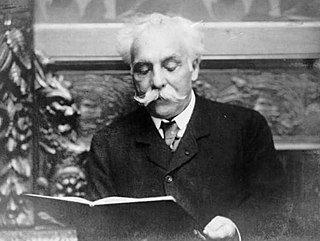
The French composer Gabriel Fauré (1845–1924) wrote in many genres, including songs, chamber music, orchestral pieces, and choral works. His compositions for piano, written between the 1860s and the 1920s, include some of his best known works.
The Sei pezzi per pianoforte, P 044, is a set of six solo piano pieces written by the Italian composer Ottorino Respighi between 1903 and 1905. These salon pieces are eclectic, drawing influence from different musical styles and composers, particularly music of earlier periods. The pieces have various musical forms and were composed separately and later published together between 1905 and 1907 in a set under the same title for editorial reasons; Respighi had not composed them conceiving them as a suite, and therefore did not intend to have uniformity among the pieces. The set, under Bongiovanni, became his first published works. Five of the six pieces are derived from earlier works by Respighi, and only one of them, the "Canone", has an extant manuscript.











